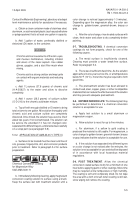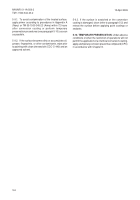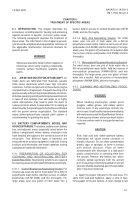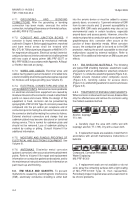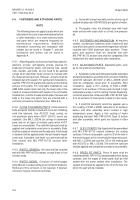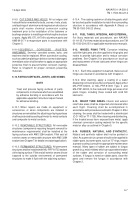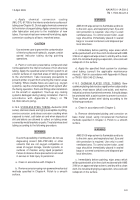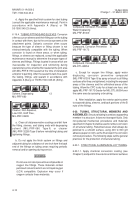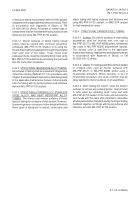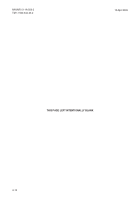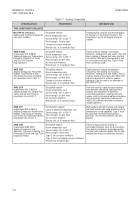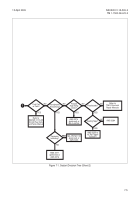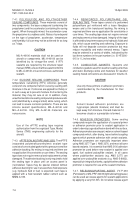TM-1-1500-344-23-2 - Page 113 of 240
6-9
NAVAIR 01-1A-509-2
TM 1-1500-344-23-2
15 April 2009
c. Apply
chemical
conversion
coating
(MIL-DTL-81706) to the interior and exterior surfaces of
tubing (see Chapter 5). Do not apply chemical conversion
to the interior of oxygen tubing. Apply conversion coating
after fabrication and prior to the installation of new
tubes. If corrosion has been removed from tubing, apply
conversion coating to all bare, reworked areas.
CAUTION
Use extreme care to prevent the contamination
of interior surfaces of hydraulic, oxygen, and air
speed indicator tubing during painting
operations.
d. Paint or corrosion preventative compound shall
not be applied to the interior surfaces of non-structural
tubing. Apply the specified exterior finish system to all
exterior surfaces or reworked areas of tubing exposed
to the environment. Take necessary precautions to
prevent primer or paint from entering the interior areas
of tubing. Where double flares are used (e.g. oxygen
systems), cap the end and apply the finish system after
the flaring operation. Paint end fittings after installation
on the aircraft or equipment. Touch-up any coating
systems damaged during tubing installation. Paint in
accordance with Appendix A (Navy) or TM
55-1500-345-23 (Army).
6-19.2. STAINLESS STEEL TUBING. Austenitic (3XX
series) stainless steels are highly susceptible to pitting,
crevice corrosion, and stress corrosion cracking when
exposed to moist, salt-laden air and when deposits of
dirt and debris are allowed to collect on tubing areas
covered by metal brackets or parts. Treat stainless steel
tubing according to the following procedure.
WARNING
Due to the possibility of combustion, do not use
degreasing solvent (MIL-PRF-680) or other
solvents that are not oxygen compatible on
areas of oxygen storage, transfer systems, or
surfaces of missiles using liquid propellant.
Failure to observe these precautions can result
in serious or fatal injury to personnel.
a. Clean in accordance with Chapter 2.
b. Remove corrosion using non-powered mechanical
methods specified in Chapter 4. Polish to a smooth
surface.
WARNING
AMS 3166 wipe solvent is flammable and toxic
to the skin, eyes, and respiratory tract. Eye and
skin protection is required. Use only in a well
ventilated area. To control solvent odor, used
rags should be immediately placed in sealed
bags or covered containers and disposed per
local directives.
c. Immediately before painting, wipe areas which
will be painted with a lint free cloth moistened with AMS
3166 or an approved wipe solvent, and dry with a clean
cloth. Do not allow drying by evaporation, since soils will
redeposit on the surface.
d. Apply the specified finish system for stainless
steel tubing (consult the applicable maintenance
manual). Paint in accordance with Appendix A (Navy)
or TM 55-1500-345-23 (Army).
6-19.3. CADMIUM PLATED STEEL TUBING. Bare
cadmium plating deteriorates rapidly when subjected to
abrasion, most bases (alkali) and acids, and marine,
industrial, and very humid environments. It should always
be protected with a paint system to prevent corrosion.
Treat cadmium plated steel tubing according to the
following procedure.
a. Clean in accordance with Chapter 2.
b. Remove deteriorated plating and corrosion on
base metal (steel) using non-powered mechanical
methods specified in Chapter 4. Polish to a smooth
surface.
WARNING
AMS 3166 wipe solvent is flammable and toxic
to the skin, eyes, and respiratory tract. Eye and
skin protection is required. Use only in a well
ventilated area. To control solvent odor, used
rags should be immediately placed in sealed
bags or covered containers and disposed per
local directives.
c. Immediately before painting, wipe areas which
will be painted with a lint free cloth moistened with AMS
3166 or an approved wipe solvent, and dry with a clean
cloth. Do not allow drying by evaporation, since soils will
redeposit on the surface.
Back to Top

